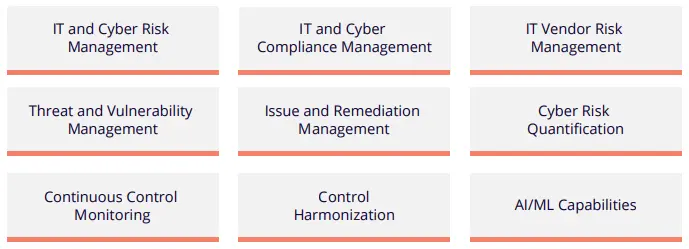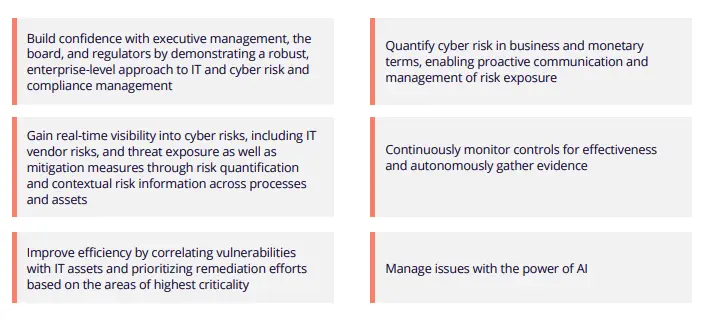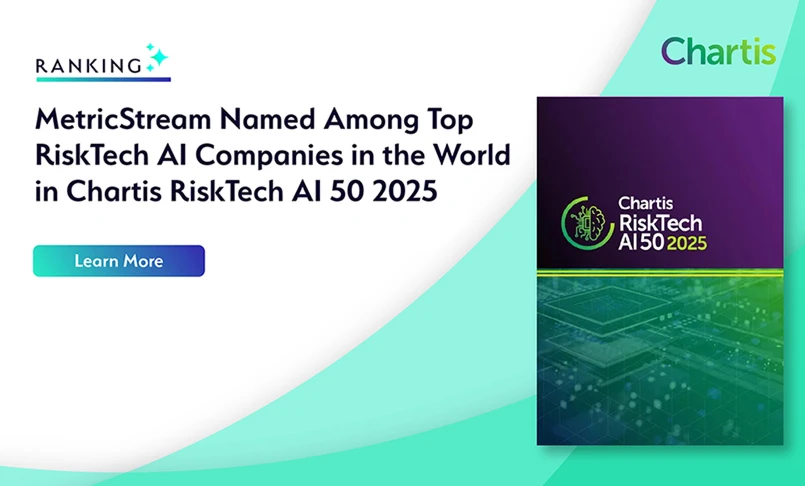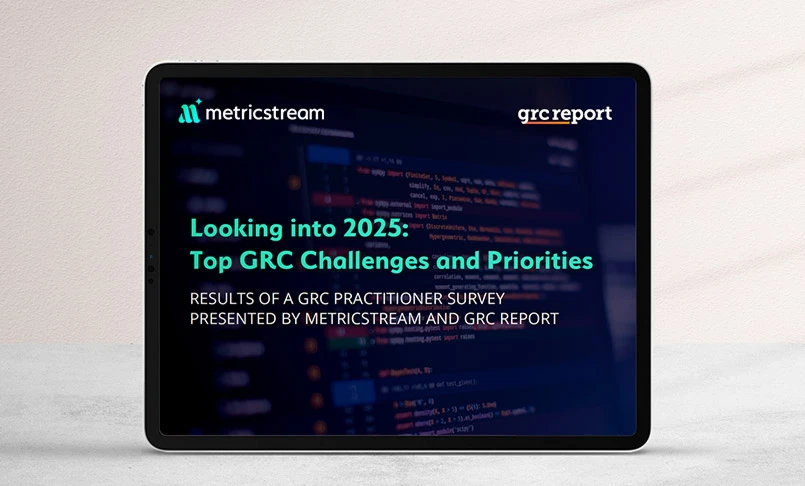Introduction
With the rapid pace of digital transformation at organizations, exposure to IT and cyber risks is also growing exponentially. From data breaches and ransomware to cloud security, to risks from third parties and IT vendors, to state-sponsored attacks, and beyond, organizations today have to tackle cyber risks from multiple dimensions. A minor lapse in the cyber security defense mechanism can result in financial losses, lack of stakeholder trust, operational disruptions, and more.
At the same time, IT and cyber compliance requirements are also growing at a remarkable pace with heightened focus on all things cyber in recent years. So, organizations have to ensure the robustness of their cyber infrastructure while ensuring compliance with multiple standards, requirements, and regulations. Given the ever-evolving cyber risk landscape, a proactive and strategic approach to IT and cyber risk and compliance management is essential – one that improves cyber risk visibility and foresight, helps to accurately understand cyber risk exposure, and enables keeping up with evolving compliance requirements. Executing on that strategy requires cyber governance, risk, and compliance (GRC) best practices, frameworks, and software. This guide is designed to help you understand what Cyber GRC means, what kinds of solutions are out there to meet your risk management needs, and how to select one that works for you.
What is Cyber GRC?
Cyber GRC is an integrated approach to managing all cyber-related governance, risk management, and compliance (GRC) processes.
For security and risk management professionals, integrated Cyber GRC software provides a unified, holistic view of their cyber risk and compliance posture. The valuable insights provided by such software, supported by data and automated workflows, drive better-informed and agile business decisions.
Key Capabilities of a Best Practice Cyber GRC Solution 
Why Do I Need a Cyber GRC Software Solution?
Cyber risk is everywhere. A minor lapse in your cyber defense mechanism or a blind spot can result in catastrophic repercussions – including loss of sensitive data, loss of reputation, loss of stakeholder trust, and operational disruptions. In extreme circumstances, it could also lead to the closure of a business.
At the same time, IT compliance is becoming an increasingly demanding business function with the growing number of IT and cyber requirements, frameworks, and frequent regulatory updates.
Last but not least, consider your IT vendor ecosystem. With the amplified digital dependencies between organizations, you need end-to-end visibility on your extended enterprise as a minor slip at the vendor’s end could lead to a major supply chain attack, compromising multiple connected organizations.
Today, with the amplified digital interconnectedness of people, processes, and organizations, the points of intersection of risks – cyber, third-party, compliance, etc. – are also multiplying. To thrive in this rapidly evolving landscape, speed of execution and agility are critical.
An integrated, best-practice driven Cyber GRC solution will enable you to link and map different functions together to see the big picture. You will get a 360-degree view of how a risk is linked to various organizational assets, processes, controls, etc.
Advanced cyber risk quantification capabilities will enable you to associate a monetary value to risks and facilitate prioritization and executive communication of risk.
Real-time analytics, reporting, and technological capabilities like AI, machine learning, and automation will empower you to stay abreast of risks and regulatory changes, boosting agility in decision-making.
Case in Point
Think about the challenges you face in your daily operations where an integrated solution can help.
For example, your risk, compliance, and security teams are working in siloes with their own sets of nomenclature and point solutions. This results in unstructured, inconsistent risk and compliance data, which is difficult to aggregate and analyze at the enterprise level.
An integrated solution will help you establish common taxonomy, cut across organizational siloes, and facilitate collaboration and harmonization across teams for streamlined Cyber GRC processes and a single view of risks.
Which Software Should I Choose for Cyber GRC?
Based on our research, a large number of organizations depend on basic office productivity software and point solutions for their cyber risk and compliance management requirements.
Office productivity software, such as spreadsheets, is manual in nature and prone to errors. The challenges are exacerbated if risk, compliance, and security teams operate in siloes, making data aggregation extremely difficult and time-consuming. It is also almost impossible to gain real-time insights, which could lead to blind spots in the cyber defense mechanism.
Point solutions help organizations automate workflows and can provide real-time insights. If you only have a single need – say, third party risk management – in one business unit, they may be the right choice. However, they fail to provide comprehensive risk and compliance visibility, with each business unit having their own point solutions without communication or collaboration among them.
An integrated, connected solution provides all the valuable insights in one place for efficient decision-making. It cuts across organizational siloes and facilitates collaboration and harmonization across business units. Real-time insights, supported by visualization tools and graphics, help CISOs, CTOs, and CSOs to quickly view the problem areas, analyze trends, and make data-driven and risk-aware decisions.
What Questions Should I Ask Before Buying a Cyber GRC Solution?
Today, businesses have a multitude of cyber risk management software solutions to choose from. However, not all are designed to address the real, day-to-day challenges faced by security professionals. So, what are the key questions that CISOs, CSOs, and CTOs must ask when making this decision?
As a starting point, we recommend starting with your existing challenges and building from there.
An excellent place to begin is this report from Gartner, titled “Ten Cyber and IT Risk Fundamentals You Must Get Right.” It recommends organizations to adopt an approach that best fits their needs, requirements, objectives, and culture, and allows risk to inform all business decisions — particularly cyber and IT risk decisions. The report delves into the fundamental cyber and IT Risk management processes and lists the key considerations for ensuring long-term success.
Here are some questions that we have often encountered with our customers:
- How can the software improve my visibility into cyber risks and associated controls?
- Is the software scalable and flexible enough to handle unforeseen changes in the business?
- Would I be able to view the assets, processes, functions, etc. impacted due to a particular risk?
- Does the software help in performing cyber risk assessments? Are both qualitative and quantitative assessments supported?
- Would I be able to prioritize the risks?
- What about the risks from IT vendors? Does the software support IT vendor and third-party risk management?
- Does the software help in ensuring compliance with industry best practices and frameworks, such as NIST, HIPAA, PCI DSS, etc.?
- How can the software help me stay on top of IT regulatory changes?
- Can I automate the process of updating corporate policies as frameworks and requirements change?
- I have a lot of duplicate controls to comply with various frameworks and regulations. Does the software help me eliminate duplication?
- Does the software help in verifying the effectiveness of controls? Is it automatic?
- What about any identified issues? How can the software help me streamline issue and remediation management?
- I need cyber risk reports, trend charts, and graphics to present to the top management and board. How can the software help?
Getting Buy-In from the Decision-Makers
Managing cyber risks and compliance processes is not just a tick-the-box exercise. It is essential that your board and C-suite executives understand the importance of an integrated Cyber GRC solution, the role it plays in driving business value, and the risk of not adopting a unified approach.
It's tempting to focus on software features, capabilities, time and cost savings, etc. However, the conversations with the top management and board must be centered around the value it brings to the business.
Getting buy-in from top management is also important to set the tone across the enterprise. Purchasing and implementing an integrated solution is one side of the coin; the other side is nurturing a risk-aware culture across the organizational hierarchy – from the top-level executives down to the frontline employees.
MetricStream Cyber GRC
MetricStream Cyber GRC helps you actively manage cyber risk through an IT and Cyber Risk and Compliance Framework that aligns with established security standards so you can pass IT audits more efficiently and get buy-in from top management. It provides comprehensive visibility into the overall IT risk posture and cybersecurity investment priorities. It helps you get your IT and Cyber Risk Compliance program up and running quickly with pre-packaged content and industry frameworks such as ISO 27001, NIST CSF, and NIST SP800-53, and map policies to IT controls and policy exceptions. The solution will empower you to strengthen your organization’s cyber resilience with built-in industry best practices, insightful reporting, and risk quantification capabilities.
Business Value

With MetricStream Cyber GRC, you can: 
Here are some of our customer case studies that provide insights into how an integrated solution has helped some leading companies improve their efficiency and cyber resilience.
Global Retailer Keeps Cybersecurity Risks in Check Through an Integrated Approach
With a gold mine of sensitive, confidential, and personally identifiable information (PII), a global retailer had to maintain stringent security controls in compliance with requirements such as the Payment Card Industry Data Security Standard (PCI-DSS). In addition, real-time, integrated visibility into cyber risks became increasingly essential for the senior leadership team to understand the organization’s risk profile and to respond proactively to emerging threats.
Their key objectives were to identify priority risks across the organization while ensuring that the business was meeting various compliance objectives and strategic goals. They also needed to determine if sufficient policies and standard operating procedures (SOPs) were available from a governance perspective.
With MetricStream Cyber GRC, the retailer has been able to implement a systematic and integrated approach to IT and cyber risk documentation, risk assessments, control management, and issue detection, as well as risk/ threat analysis and reporting. The solution has enabled the senior-most leadership, C-suite members, board members, and external stakeholders to prioritize and align IT and cyber risks to business risks. Advanced reports and dashboards provide a real-time view of the risks, enabling senior stakeholders to make well-informed decisions.
The retailer can also efficiently manage all compliance requirements related to PCI-DSS and the Sarbanes Oxley Act (SOX). It supports the process of harmonizing control sets across multiple IT regulations. It also helps in scheduling assessments and performing control tests.
As cybersecurity evolved into a top 3 business risk, boards and leadership teams wanted more insights than what a traditional risk heat map provided: “What is the financial impact of a potential data breach?”, “How much is the cost of remediating the risk vs accepting it?”, “Are our cybersecurity investments proportionate to our risk exposure?”
The only way to answer these questions was to quantify the company’s cyber risks in monetary terms. Today, MetricStream Cyber Risk Quantification is helping the company transform cyber risk data into a single risk score that’s quantified in terms of dollar impact. These actionable insights have accelerated decision-making time by 60%.
Summary
We hope our Buyer’s Guide will help you choose the right Cyber GRC solution for your organization. Cyber governance, risk, and compliance processes are complex business functions with multiple stakeholders. It is imperative to streamline the activities with clear accountabilities and responsibilities of those involved. A Cyber GRC program can help you achieve this and much more – from actionable GRC data and insights to improved visibility and foresight into GRC processes, to tracking of key processes end-to-end, to strengthening trust with customers, investors, regulators, and other stakeholders, and beyond. MetricStream has been a leading GRC partner for organizations across industries for over two decades. We are here to help answer any questions you have about GRC, strengthening organizational resilience, and preparing your organization for what’s next. Please feel free to reach out to us. We are here to help you succeed on your Cyber GRC journey!
With the rapid pace of digital transformation at organizations, exposure to IT and cyber risks is also growing exponentially. From data breaches and ransomware to cloud security, to risks from third parties and IT vendors, to state-sponsored attacks, and beyond, organizations today have to tackle cyber risks from multiple dimensions. A minor lapse in the cyber security defense mechanism can result in financial losses, lack of stakeholder trust, operational disruptions, and more.
At the same time, IT and cyber compliance requirements are also growing at a remarkable pace with heightened focus on all things cyber in recent years. So, organizations have to ensure the robustness of their cyber infrastructure while ensuring compliance with multiple standards, requirements, and regulations. Given the ever-evolving cyber risk landscape, a proactive and strategic approach to IT and cyber risk and compliance management is essential – one that improves cyber risk visibility and foresight, helps to accurately understand cyber risk exposure, and enables keeping up with evolving compliance requirements. Executing on that strategy requires cyber governance, risk, and compliance (GRC) best practices, frameworks, and software. This guide is designed to help you understand what Cyber GRC means, what kinds of solutions are out there to meet your risk management needs, and how to select one that works for you.
Cyber GRC is an integrated approach to managing all cyber-related governance, risk management, and compliance (GRC) processes.
For security and risk management professionals, integrated Cyber GRC software provides a unified, holistic view of their cyber risk and compliance posture. The valuable insights provided by such software, supported by data and automated workflows, drive better-informed and agile business decisions.
Key Capabilities of a Best Practice Cyber GRC Solution 
Cyber risk is everywhere. A minor lapse in your cyber defense mechanism or a blind spot can result in catastrophic repercussions – including loss of sensitive data, loss of reputation, loss of stakeholder trust, and operational disruptions. In extreme circumstances, it could also lead to the closure of a business.
At the same time, IT compliance is becoming an increasingly demanding business function with the growing number of IT and cyber requirements, frameworks, and frequent regulatory updates.
Last but not least, consider your IT vendor ecosystem. With the amplified digital dependencies between organizations, you need end-to-end visibility on your extended enterprise as a minor slip at the vendor’s end could lead to a major supply chain attack, compromising multiple connected organizations.
Today, with the amplified digital interconnectedness of people, processes, and organizations, the points of intersection of risks – cyber, third-party, compliance, etc. – are also multiplying. To thrive in this rapidly evolving landscape, speed of execution and agility are critical.
An integrated, best-practice driven Cyber GRC solution will enable you to link and map different functions together to see the big picture. You will get a 360-degree view of how a risk is linked to various organizational assets, processes, controls, etc.
Advanced cyber risk quantification capabilities will enable you to associate a monetary value to risks and facilitate prioritization and executive communication of risk.
Real-time analytics, reporting, and technological capabilities like AI, machine learning, and automation will empower you to stay abreast of risks and regulatory changes, boosting agility in decision-making.
Case in Point
Think about the challenges you face in your daily operations where an integrated solution can help.
For example, your risk, compliance, and security teams are working in siloes with their own sets of nomenclature and point solutions. This results in unstructured, inconsistent risk and compliance data, which is difficult to aggregate and analyze at the enterprise level.
An integrated solution will help you establish common taxonomy, cut across organizational siloes, and facilitate collaboration and harmonization across teams for streamlined Cyber GRC processes and a single view of risks.
Based on our research, a large number of organizations depend on basic office productivity software and point solutions for their cyber risk and compliance management requirements.
Office productivity software, such as spreadsheets, is manual in nature and prone to errors. The challenges are exacerbated if risk, compliance, and security teams operate in siloes, making data aggregation extremely difficult and time-consuming. It is also almost impossible to gain real-time insights, which could lead to blind spots in the cyber defense mechanism.
Point solutions help organizations automate workflows and can provide real-time insights. If you only have a single need – say, third party risk management – in one business unit, they may be the right choice. However, they fail to provide comprehensive risk and compliance visibility, with each business unit having their own point solutions without communication or collaboration among them.
An integrated, connected solution provides all the valuable insights in one place for efficient decision-making. It cuts across organizational siloes and facilitates collaboration and harmonization across business units. Real-time insights, supported by visualization tools and graphics, help CISOs, CTOs, and CSOs to quickly view the problem areas, analyze trends, and make data-driven and risk-aware decisions.
Today, businesses have a multitude of cyber risk management software solutions to choose from. However, not all are designed to address the real, day-to-day challenges faced by security professionals. So, what are the key questions that CISOs, CSOs, and CTOs must ask when making this decision?
As a starting point, we recommend starting with your existing challenges and building from there.
An excellent place to begin is this report from Gartner, titled “Ten Cyber and IT Risk Fundamentals You Must Get Right.” It recommends organizations to adopt an approach that best fits their needs, requirements, objectives, and culture, and allows risk to inform all business decisions — particularly cyber and IT risk decisions. The report delves into the fundamental cyber and IT Risk management processes and lists the key considerations for ensuring long-term success.
Here are some questions that we have often encountered with our customers:
- How can the software improve my visibility into cyber risks and associated controls?
- Is the software scalable and flexible enough to handle unforeseen changes in the business?
- Would I be able to view the assets, processes, functions, etc. impacted due to a particular risk?
- Does the software help in performing cyber risk assessments? Are both qualitative and quantitative assessments supported?
- Would I be able to prioritize the risks?
- What about the risks from IT vendors? Does the software support IT vendor and third-party risk management?
- Does the software help in ensuring compliance with industry best practices and frameworks, such as NIST, HIPAA, PCI DSS, etc.?
- How can the software help me stay on top of IT regulatory changes?
- Can I automate the process of updating corporate policies as frameworks and requirements change?
- I have a lot of duplicate controls to comply with various frameworks and regulations. Does the software help me eliminate duplication?
- Does the software help in verifying the effectiveness of controls? Is it automatic?
- What about any identified issues? How can the software help me streamline issue and remediation management?
- I need cyber risk reports, trend charts, and graphics to present to the top management and board. How can the software help?
Getting Buy-In from the Decision-Makers
Managing cyber risks and compliance processes is not just a tick-the-box exercise. It is essential that your board and C-suite executives understand the importance of an integrated Cyber GRC solution, the role it plays in driving business value, and the risk of not adopting a unified approach.
It's tempting to focus on software features, capabilities, time and cost savings, etc. However, the conversations with the top management and board must be centered around the value it brings to the business.
Getting buy-in from top management is also important to set the tone across the enterprise. Purchasing and implementing an integrated solution is one side of the coin; the other side is nurturing a risk-aware culture across the organizational hierarchy – from the top-level executives down to the frontline employees.
MetricStream Cyber GRC helps you actively manage cyber risk through an IT and Cyber Risk and Compliance Framework that aligns with established security standards so you can pass IT audits more efficiently and get buy-in from top management. It provides comprehensive visibility into the overall IT risk posture and cybersecurity investment priorities. It helps you get your IT and Cyber Risk Compliance program up and running quickly with pre-packaged content and industry frameworks such as ISO 27001, NIST CSF, and NIST SP800-53, and map policies to IT controls and policy exceptions. The solution will empower you to strengthen your organization’s cyber resilience with built-in industry best practices, insightful reporting, and risk quantification capabilities.
Business Value

With MetricStream Cyber GRC, you can: 
Here are some of our customer case studies that provide insights into how an integrated solution has helped some leading companies improve their efficiency and cyber resilience.
Global Retailer Keeps Cybersecurity Risks in Check Through an Integrated Approach
With a gold mine of sensitive, confidential, and personally identifiable information (PII), a global retailer had to maintain stringent security controls in compliance with requirements such as the Payment Card Industry Data Security Standard (PCI-DSS). In addition, real-time, integrated visibility into cyber risks became increasingly essential for the senior leadership team to understand the organization’s risk profile and to respond proactively to emerging threats.
Their key objectives were to identify priority risks across the organization while ensuring that the business was meeting various compliance objectives and strategic goals. They also needed to determine if sufficient policies and standard operating procedures (SOPs) were available from a governance perspective.
With MetricStream Cyber GRC, the retailer has been able to implement a systematic and integrated approach to IT and cyber risk documentation, risk assessments, control management, and issue detection, as well as risk/ threat analysis and reporting. The solution has enabled the senior-most leadership, C-suite members, board members, and external stakeholders to prioritize and align IT and cyber risks to business risks. Advanced reports and dashboards provide a real-time view of the risks, enabling senior stakeholders to make well-informed decisions.
The retailer can also efficiently manage all compliance requirements related to PCI-DSS and the Sarbanes Oxley Act (SOX). It supports the process of harmonizing control sets across multiple IT regulations. It also helps in scheduling assessments and performing control tests.
As cybersecurity evolved into a top 3 business risk, boards and leadership teams wanted more insights than what a traditional risk heat map provided: “What is the financial impact of a potential data breach?”, “How much is the cost of remediating the risk vs accepting it?”, “Are our cybersecurity investments proportionate to our risk exposure?”
The only way to answer these questions was to quantify the company’s cyber risks in monetary terms. Today, MetricStream Cyber Risk Quantification is helping the company transform cyber risk data into a single risk score that’s quantified in terms of dollar impact. These actionable insights have accelerated decision-making time by 60%.
We hope our Buyer’s Guide will help you choose the right Cyber GRC solution for your organization. Cyber governance, risk, and compliance processes are complex business functions with multiple stakeholders. It is imperative to streamline the activities with clear accountabilities and responsibilities of those involved. A Cyber GRC program can help you achieve this and much more – from actionable GRC data and insights to improved visibility and foresight into GRC processes, to tracking of key processes end-to-end, to strengthening trust with customers, investors, regulators, and other stakeholders, and beyond. MetricStream has been a leading GRC partner for organizations across industries for over two decades. We are here to help answer any questions you have about GRC, strengthening organizational resilience, and preparing your organization for what’s next. Please feel free to reach out to us. We are here to help you succeed on your Cyber GRC journey!








